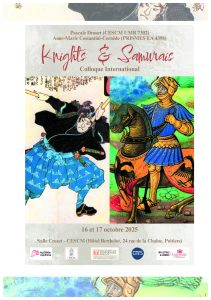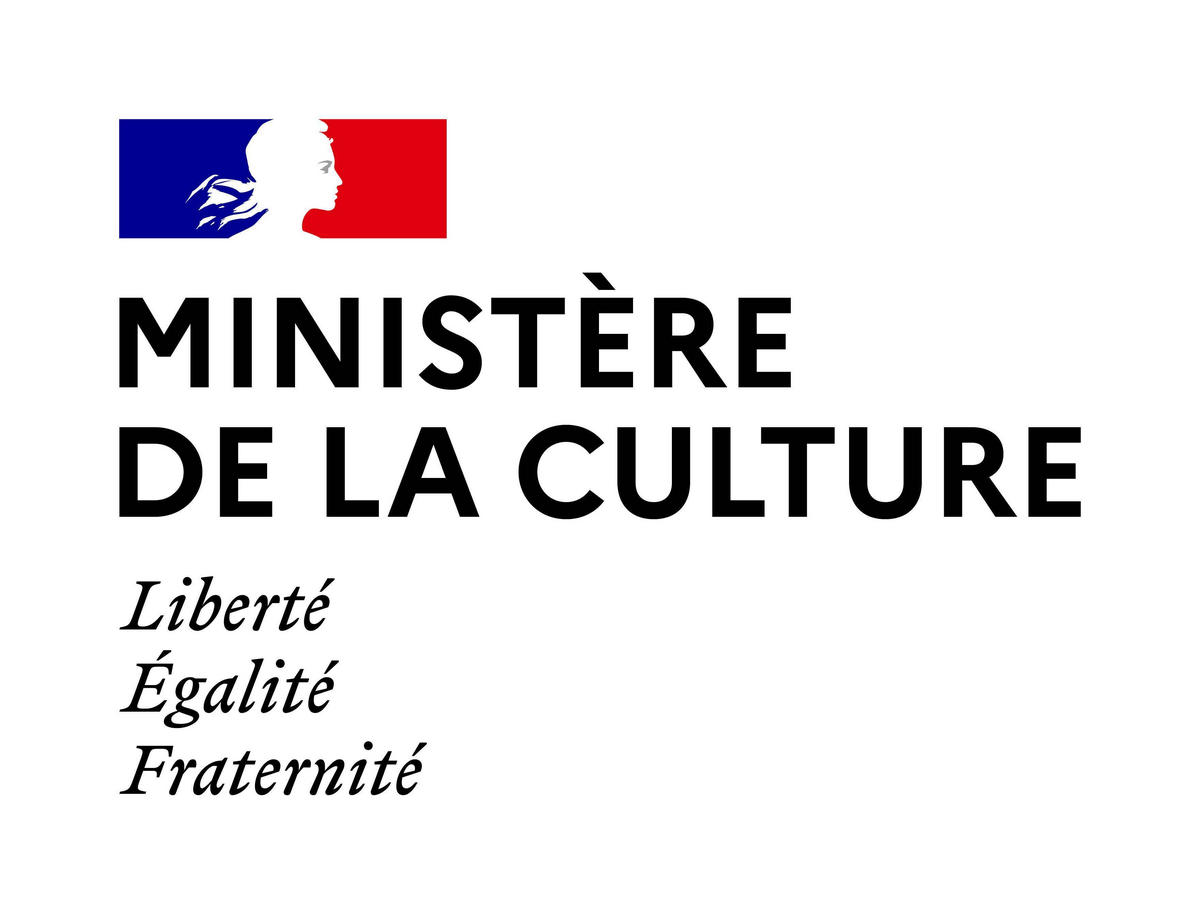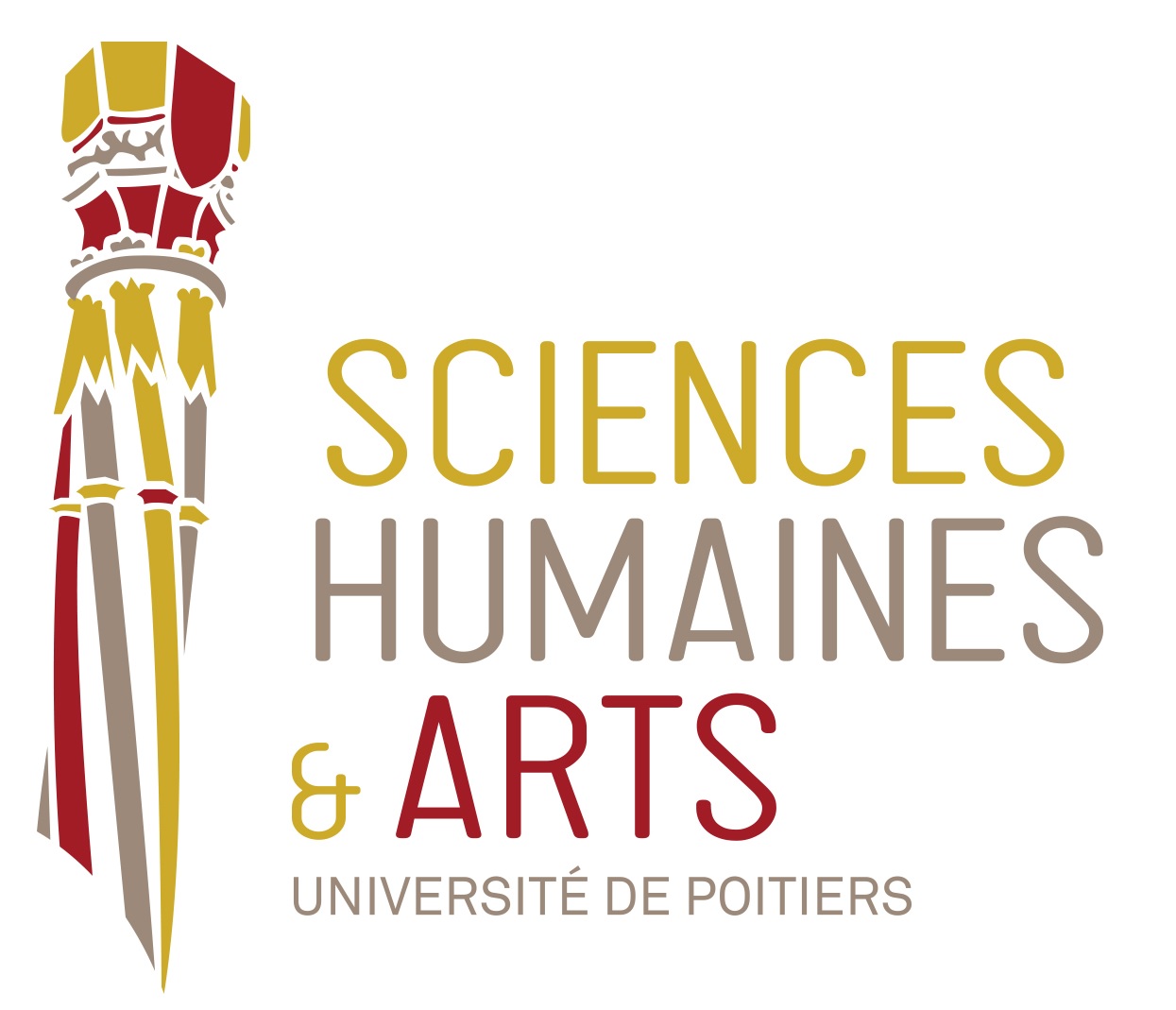Jeudi 16 octobre 2025
13h / Accueil des participants
13h30 / Ouverture du colloque par Anne-Cécile Guilbard (Assesseure à la Recherche de l’UFR Lettres & Langues) et Cécile Voyer (Directrice du CESCM, de l’UFR Sciences Humaines et Arts)
13h45-14h / Introduction par Pascale Drouet (Université de Poitiers-CESCM) et Anne-Marie Costantini-Cornède (Sorbonne Nouvelle-PRISMES)
1. Chevaliers, samouraïs : tournants historiques, enjeux culturels et ambiguïtés éthiques
Présidente de séance : Pascale Drouet
14h-14h30 / Marion Bracq (Université de Lille 3) : « Quand la Sword and Sorcery italienne revisitait l’Orlando furioso de l’Arioste : I Paladini, storia d’armi et d’amori de Giacomo Battiato (1984) »
14h30-15h / Pierre Levron (Chargé de recherches au CNRS (UMR 7302, CESCM) : « Existe-t-il un droit de la chevalerie, ou : la littérature servirait-elle à l’enseignement de la coutume ? Enquête dans le Roman de Tristan en Prose »
15h-15h30 / Anne-Marie Costantini-Cornède (Université Sorbonne Nouvelle, Paris Cité) : « Visions of Samurai and Knighthood: Kurosawa’s and Other Jidaigeki, Intercultural Perspectives »
Questions (15mn) & pause (15 min)
2. Samouraïs et Japon féodal : enjeux historiques et mythologiques
Président de séance : Claire Guéron
16h-16h30 / Delphine MULARD (Université de Strasbourg) : « Évolution de la figure du guerrier chasseur de démon : étude de la représentation du récit Shutendôji (le Jouvenceau buveur) »
16h30-17h / Natalia DOAN (University of Tennessee, Knoxville) : « The 1860 Japanese Embassy and the Transnational Influence of Tokugawa Japan »
17h-17h30 / Jean DU VERGER (ENSMM Besançon, VALE) : « The Woman as Spider in Early Modern Japan in Tanizaki’s “Shisei” (1909) and Masumura’s Irezumi (1966) »
Questions (15mn)
Apéritif de bienvenue au CESCM, salle Berger (18h)
Vendredi 17 octobre 2025
3. Enjeux médiévaux culturels : études comparatives
Présidente de séance : Anne-Hélène Miller
9h30-10h / Marta Añorbe-Mateaos (University of Zaragoza) : « The Self-questioning Hero: A Comparative Study of the Heroic Model of Taira no Shigemori and Perceval »
10h-10h30 / Claire Guéron (Université de Bourgogne) : « La notion de “geste juste” dans le bushido et chez le guerrier shakespearien »
10h30-11h / Matthew Bryan Gillis (University of Tennessee, Marco Institute) : « Aestheticized Slaughter and Soldier Martyrdom in Pseudo-Turpin’s Historia Karoli Magni et Rotholandi »
Questions (15 mn) & pause (15mm)
Président de séance : Matthew Bryan Gillis
12h-12h30 / Anne-Hélène Miller (University of Tennessee, Marco Institute) : « Re-inventing the Warrior Image in Time of Peace: Survival or Nostalgia? »
Questions (15mn)
12h45-14h15 déjeuner sur place (salle Berger)
4. Samouraïs et chevaliers : cinéma et histoire, enjeux artistiques
Présidente de séance : Anne-Marie Costantini-Cornède
14h30-15h / Jessica X. Dabouin (Université de Paris 1, ACTE) « Way of the Scissor-shears: Tadanori Yokoo’s depiction of samurai from the 1960s to today »
15h-15h30 / Minh Vu Cong (Université de Lille 3), « Macbeth, de l’invraisemblable Moyen-Âge écossais à la fable baroque chez les samouraïs »
15h30-16h / Gilles Ménégaldo (Université de Poitiers, Professeur émérite), « Deux avatars cinématographiques du mythe arthurien : Excalibur (John Boorman, 1981) et Lancelot du lac (Robert Bresson, 1974) : entre spectaculaire et minimalisme »
Questions (15mn) & pause (15 minutes)
Président de séance : Gilles Ménégaldo
16h30-17h / Sergio Boffa (Conservateur de Musée Nivelles, Belgique), « Une interprétation divergente du film Hara-kiri (Seppuku) de Kobayashi Masaki »
17h-17h30 / Andrea Grunert (Université de Bochum, Allemagne), « Critique du bushidō dans cinq jidai geki des années 1960 »
17h30-18h / Pascale Drouet (Université de Poitiers / CESCM), « Rulers and Counterfeiters: from Shakespeare’s 1 Henry IV to Welles’s Chimes at Midnight (1965) and Kurosawa’s Kagemusha (1980) »
Questions (15mn)
18h30 Clôture du colloque
Dîner de clôture en ville 19h30

Informations complémentaires
ABSTRACTS
- The Self-Questioning Hero: A Comparative Study of the Heroic Model of Taira no Shigemori and Perceval / Marta Añorbe Mateos – (Ph.D student, University of Zaragoza (Spain)
This research explores the evolution of the heroic figure from practical prehistoric archetypes to ethically-driven heroes across Eastern and Western cultures through a comparative analysis of Taira no Shigemori from Heike Monogatari and Perceval from Li Contes del Graal. Drawing on scholars like Cavanaugh (2009), the study highlights the convergence of filial, secular, and divine duties in pre-modern Japan and medieval Europe, challenging conventional divisions in these morally complex heroes. It also critiques prevailing notions of Western and Japanese heroism, such as those of Morris (1975), by demonstrating that both heroic models, though failed, perform similar functions, and seek existential affirmation. This comparison deepens our understanding of the “culturally encoded epistemology” (Mori, 1996) that shapes the heroic narratives.
- A Divergent Interpretation of Kobayashi Masaki’s Hara-Kiri / Sergio Boffa (Curator and Resarch Associate, Université Libre de Bruxelles (Belgium) and Musée Communal de Nivelles)
Film critics generally present Kobayashi’s Hara-Kiri as a harsh critique of the bushidō. This is not a mistake, but we think it is a superficial interpretation of this drama. It is important to remember that bushidō changes radically over the course of its history. To grasp the motivations and understand the actions of the protagonists in Kobayashi’s film, the viewer must be familiar with the specifics of bushidō in the period in question, i.e. the year 1630. We will show that Hara-Kiri is not a virulent attack on the ‘way of the warrior’, but rather a critique of the decadence of the bushido during the Tokugawa period, when it became a propaganda tool for the government.
- Representations of Ariosto’s Orlando furioso in a Sword and Sorcery Movie: I paladini, storia d’arme e di amori de Giacomo Battiato (1984) / Marion Bracq (Doctor and Independent researcher)
This paper investigates how Ariosto’s fiction is transmitted and adapted through a Sword and Sorcery movie: I paladini, Storia d’armi et d’amori by Giacomo Battiato (1984). The director’s choices of script and themes show how he tries to manage the original material with the characteristics of the Sword and Sorcery’s aesthetic based on romance and fight. In fact, even if it is a free adaptation, there are explicit references to the epic poem. Moreover, as in Ariosto’s poem, heroes and heroines come together, seek each other out and find each other again. This paper will examine the importance of duos, duels and couples in the film’s narrative construction.
- The Softer Side of Warrior Culture – Medieval Samurai and Knights Who Wrote Poetry / Małgorzata K. Citko-DuPlantis (Ph.D University of Tennessee, Knoxville (US)
Medieval Japanese warriors (bushi), known as samurai, were not only associated with violence but also with refined court culture, such as court poetry (waka). The Kamakura shogunate, established after the Genpei War in 1185, marked the rise of the samurai class. Although they were military nobility, the shogunate valued cultural pursuits, with notable figures like shogun Minamoto no Sanetomo (1192–1219) studying waka under the celebrated poet Fujiwara no Teika (1162–1241). This cultural engagement by samurai and shoguns reflected a softer side, challenging the violent image often portrayed in Western media. The paper explores these aspects and compares them to medieval European knights, highlighting the role of literary training in shaping masculine ideals across different warrior cultures.
- Visions of Samurai and Knighthood: Kurosawa’s and Other Jidaigeki, Intercultural Perspectives / Anne-Marie Costantini-Cornède (Senior Lecturer, Université de Paris Cité (France)
This paper explores Kurosawa’s complex samurai figures as illustrative of Japan’s medieval history and evolving cultural contexts. Whether they are enacting mythic, Buddhist-imbued Kamakura heroes (Minamoto), ambivalent ronin and community protectors (Seven Samurai), tragically falling Sengoku jidai, Warring States warriors (Throne of Blood, Kagemusha, Ran), or Bakumatsu unconventional ronin (Yojimbo)—all films demonstrate in spectacular aesthetics how glorious feats are sustained both by timely spiritual beliefs and universal ideals. This paper furthermore considers how Giri-driven Bushido was perverted during gekokujô times, which highlights its underlying contradictions and questions of human frailties. The analysis also addresses links with Western chivalry, East-West mystiques and potential ethical bridges, and the ‘nowness’ of the Knighthood spirit.
- Way of the Scissor-shears: Tadanori Yokoo’s Depiction of Samurai from the 1960s to Today / Jessica X. Dabouin (University of Paris I Panthéon, Sorbonne student, Sorbonne Ecole des Arts Plastiques (France)
This paper analyses how Yokoo’s artworks re-question the samurai’s status as an emblem of power and feudal social hierarchies. It examines how the samurai figure, in Yokoo’s collaborations with avant-garde artists such as Ôshima and Kara, begins to widen perspectives through the juxtaposition of premodern and Western pop culture imagery. The samurai’s complexities as icons of rebellion, as well as the samurai ethos and understanding of mortality, are further explored in Yokoo’s collaborations with Mishima developing an original and remedial outlook, as shown by his 1969 poster for Mishima’s kabuki play about Minamoto no Tametomo. Forever renegotiating registers of autobiography, nostalgia, and playfulness, the artist offers “scissor shears”-like, innovative depictions.
- The 1860 Japanese Embassy and the Transnational Influence of Tokugawa Japan / Natalie Doan (Assistant Professor at the University of Tennesees, Knoxville/Marco Institute)
In 1860, seventeen-year-old samurai Tateishi Onojir made headlines across America for his real and imagined adventures as part of the 1860 Japanese Embassy, the first Japanese diplomatic mission to the United States. The perception of Tateishi’s interracial romantic encounters with American women sparked a cultural frenzy within the US that challenged linked conceptions of race, masculinity, and power. Examining the 1860 embassy reveals samurai serving as both a bridge between the United States and Japan, as well as a source of controversy in the United States at the time. This paper explores the transnational influence of Tokugawa Japan on identity formation, cultural productions, and intellectual discourse in antebellum America to share a new cultural history of Japan’s influence overseas.
- Rulers and Counterfeiters: from Shakespeare’s 1 Henry IV to Welles’s Chimes at Midnight (1965) and Kurosawa’s Kagemusha (1980) / Pascale Drouet (Professor of British Early Modern Studies, CESCM/University of Poitiers (France)
In the wake of Alex Watson’s analysis – “Shadowing Shakespeare: Akira Kurosawa’s Kagemusha (1980) and William Shakespeare’s English History Plays (c. 1591–98)” –, this paper will focus on the dialectics of the original and the double, the ruler and the subject, simulated life and simulated death. It narrows the focus on the counterfeiter himself, that is, Sir John Falstaff, the rogue, Sir Walter Blunt – King Henry IV’s “many marching in his coat” (5.3.25) or “his wardrobe” (27) – and Kagemusha, the shadow warrior of Takeda Shingen. It addresses their dramatic and meta-dramatic qualities, the political, ethical and symbolical questions they raise, and their specific aesthetics on screen (in both the Welles and Kurosawa productions) by examining their visual representation on the battlefields.
- The Woman as Spider in Early Modern Japan in Tanizaki’s “Shisei” (1909) and Masumura’s Irezumi (1966) / Jean Du Verger (Associate Professsor, SupMicroTech-ENSMM (France)
During the early modern period in Europe, the spider was portrayed by artists as a figure of artistic subtlety, while also being depicted as a symbol of passion. This duality was reverberated in Japan during the Tokugawa shogunate, as Tanizaki Jun’ichirȏ’s short story “Shisei” (1909) attests to. In 1966, Japanese film director Masumura Yasuzȏ adapted it to film. Irezumi focuses on the sexual and aesthetic aspects of the artist’s yearnings. This paper explores how the writer and film director represent their vision of XVIIth century Japan, and more precisely the way in which they portray the fallen ukiyo-e painter, turned tattooist and envision the question of art, while highlighting the status of women in early modern Japan.
- Aestheticized Slaughter and Soldier Martyrdom in Pseudo-Turpin’s Historia Karoli Magni et Rotholandi / Matthew Bryan Gillis (Associate Professor, University of Tennessee, Knoxville (US)
This paper examines the aesthetics of violence and death in Pseudo-Turpin’s twelfth-century Historia Karoli Magni et Rotholandi. My interest will be to see how elaborately staged scenes of battle and martyrdom could have increased the audience’s pleasure in imaginatively experiencing war’s terrors while reading or hearing the text. The essay draws inspiration from medieval Japan’s The Tale of the Heike, which aestheticizes warrior deaths for the purpose of dramatization and readerly enjoyment.
- A Critical View on bushidō in five jidai geki of the 1960s / Andrea Grunert (Independent scholar (Germany)
The jidai geki (historical films set in the Tokugawa period, 1603-1868) was a successful genre in Japan throughout the 1950s, but its decline began towards the end of that decade. However, a large number of major jidai geki were made in the following years. Five films that critically address the values of the samurai, the warrior class are at the core of the article: Masaki Kobayashi’s Harakiri (Seppuku, 1962) and Samurai Rebellion (Jōiuchi: hairyō tsuma shimatsu, 1967), Eiichi Kudo’s 13 Assassins (Jūsan-nin no shikaku, 1963), Tadashi Imai’s Cruel Tale of Bushidō (Bushidō zankoku monogatari, 1963) and Hideo Gosha’s Three Outlaw Samurai (Sanbiki no samurai, 1964). The criticism of bushidō, “the way of the warrior”, articulated in these films targets not only the past but also post-war Japan’s entrepreneurial culture inspired by interpretations of bushidō.
- The « right movement » in Bushido and for Shakespeare’s Warriors / Claire Guéron (Professor, Université de Bourgogne (France)
Japanese martial arts were a “do”, meaning a “way” or method for achieving invincibility by aligning one’s movements and breath with the energy of the universe (“chi”). This principle seems poles apart from the providential chivalric ethos depicted in Shakespeare’s histories, according to which God leads the victor’s hand. Nevertheless, the ideal of the perfectly honed gesture is adumbrated in Shakespeare’s plays, as in The Merchant of Venice, when Bassanio reminds Antonio that the archer’s perfectly executed, endlessly repeatable gesture allows him to project his spirit into the future. This paper will discuss whether the “right movement”, in Shakespeare’s plays, may, despite certain negative connotations of ritualized gestures (inhumanity, Catholicism, black magic, theatricality) approach the “do” of the samurai.
- The Law of Chivalry (Literature or Custom?): Investigation into the Roman de Tristan en prose / Pierre Levron (fellow researcher at the CNRS, CESCM/University of Poitiers (France)
Western knights were subjects of the law, and Western vernacular literature developed when the codification of customary law was under way. What does this mean? Chansons de geste, but also novels, may be the arenas in which fictional chivalric customs were developed and could be transposed into actual practices. This paper will focus on the Roman de Tristan en prose. This long text, integrating the material of Tristan and Yseut with the material of Brittany, is essentially a novel of chivalry, i.e., it narrates battles but also questions of their regulation. The Roman de Tristan en prose examines both ‘objective’ and ‘subjective’ rights, an ethic with its ambiguities, and the interaction between these values and the behaviours of knights. These main issues will be addressed.
- Two Cinematic Avatars of the Arthurian Myth: Excalibur (John Boorman, 1981) and Lancelot du lac (Robert Bresson, 1974): High Entertainment versus Minimalism / Gilles Menegaldo (Emeritus Professor, University of Poitiers (France)
This paper compares two radically different visions. Boorman plays the epic and spectacular card, as the opening sequence illustrates. He summons the familiar characters from the Arthurian myth, in particular Merlin and Morgana. Adapting Mallory’s La Morte d’Arthur, he exploits the symbolic wealth of the tale, featuring warlike adventures and foregrounding King Arthur’s and Percival’s spiritual quest. Boorman rejects realism and his direction is full of baroque and dreamlike images. Bresson’s film is minimalist. He erases numerous characters, condenses space and plays down the epic. Bodies are fragmented, filmed in metonymic shots that obscure their faces. Soundtrack is emphasized. Bresson rejects the spectacular and highlights the failure of the quest for the Grail and the impossibility of love between Guinevere and Lancelot, a superhuman hero plagued by doubt and whose inevitable death is de-dramatized.
- Re-inventing the Warrior Image in Time of Peace: Survival or Nostalgia? / Anne-Hélène Miller (Associate Professor, University of Tennessee, Riggsby Director of the Marco Institute (US)
Combat attire and armor became an outward display of social status in the Ancien Regime and the Restoration of the Monarchy in France. The image of the warrior elite was associated with the establishment of peace and unity. This paper will ask whether such a reinvention of the medieval warrior image in post-medieval times was a matter of caste survival or nostalgia. And, can the highly sophisticated design of clothing and equipment of the samurai, as found for instance in the famous Picture Books of Medieval Warriors (1836) illustrated by K. Hokusai during the peaceful time of the Edo period in Japan find commonalities with the transformation of the purpose and representation of the warrior caste in Western Europe?
- Evolution of the Demon-Hunting Warrior Figure: A Study of the Representation in the Shutendôji Narrative / Delphine Mulard (Associate professor at the University of Strasbourg (France)
The narrative of the Shutendôji portrays a warrior from the 10th century, Minamoto no Yorimitsu (or Raikô (944-1021) subduing an ogre, the Shutendôji, who abducted aristocratic women to devour them. The story achieved immense success during the Edo period as it demonstrated the superiority of warriors over the aristocratic world. The objective is to demonstrate how the Shutendôji narrative serves the political and symbolic ambitions of warriors during the Muromachi period in their quest for cultural legitimacy. We will also explore how this narrative persisted during the Edo period and how the image of the warrior was propagated through new illustrations.
- Macbeth, from the Improbable Scottish Middle Ages to the Baroque Fable among the Samurai / Cong Minh Vu (Doctor, Catholic University of Lille (France)
From the same Shakespeare play, Macbeth, two completely different interpretations were taken in barely ten years from two immense filmmakers, Orson Welles (1948) and Akira Kurosawa (1957). If Welles insisted on highlighting the text, even if it meant inventing new diction and even cutting up and sometimes reworking the text, Kurosawa ignores the language of the Bard in order to preserve the plot. In this article, we therefore wish to compare the staging of these two masterpieces to bring to light their specific issues, which nevertheless come together in an eminently moral concern.




